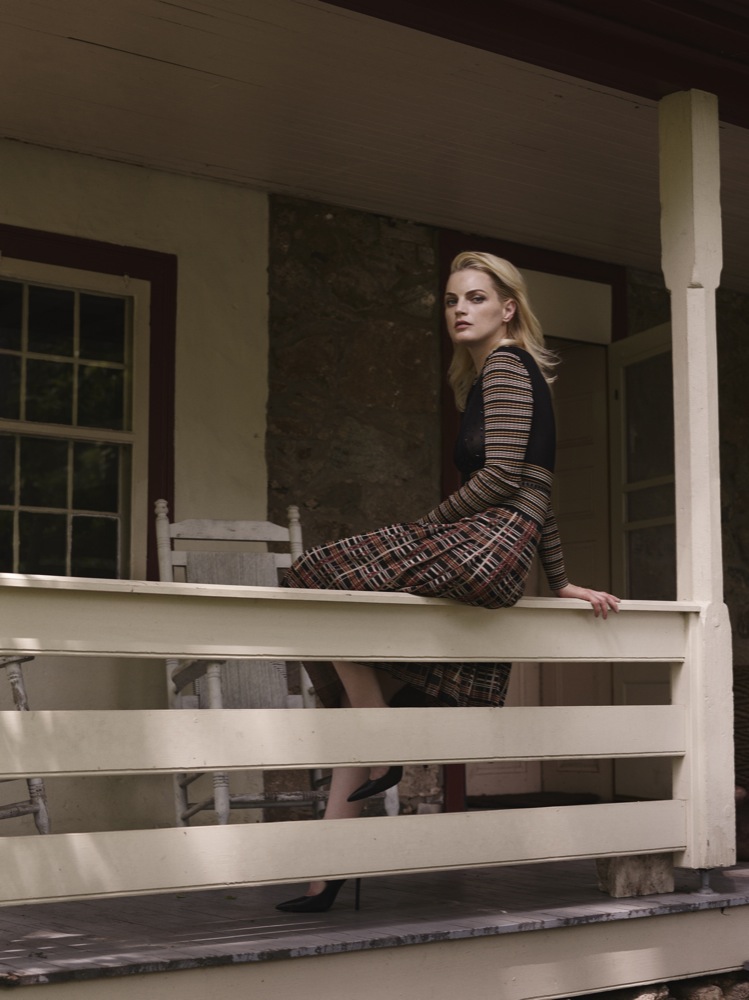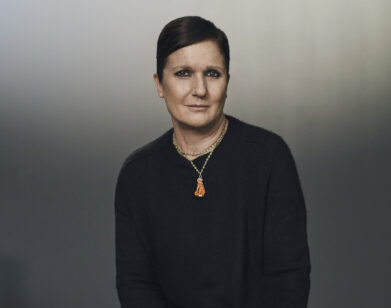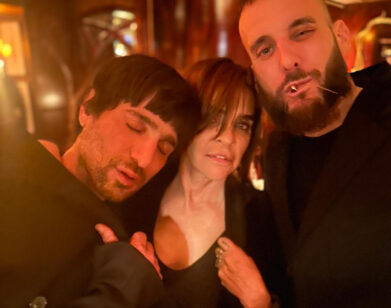The Secrets of Guinevere Van Seenus
GUINEVERE VAN SEENUS/THE LIONS IN GLENMOORE, PENNSYLVANIA, AUGUST, 2016. PHOTOS: MATTHEW SPROUT/EXPOSURE. STYLING: LIZ MCLEAN/WALTER SCHUPFER. HAIR: HOLLY MILLS FOR AVEDA/TIM HOWARD MANAGEMENT. MAKEUP: RIE OMOTO/SEE MANAGEMENT. PHOTO ASSISTANTS: JONATHAN FASULO AND SPENCER WOHLRAB.
Over the last 20 years, supermodel Guinevere van Seenus has collaborated with the most revered photographers in fashion: from Irving Penn to Roe Ethridge to Steven Meisel to Mario Sorrenti to Craig McDean (she was one of the three subjects of Sorrenti’s 2013 book, Amber, Guinevere & Kate Photographed by Craig McDean: 1993-2005, alongside Amber Valletta and Kate Moss). Ask her if any one photographer stood out, and her answer is a fair one: “I am fortunate to be able to say that this is an impossible question to answer without writing at least a short book,” she tells us.
Van Seenus’ career is remarkable in that, like Ms. Moss, she has never had slump nor a “comeback.” In 1996, she appeared on her first American magazine cover, and later that same year, she was nominated for VH1’s “model of the year” award. Throughout the 90s, she modeled for the likes of Chanel, Jil Sander, and Versace. In the 2000s, she worked as a face of NARS, Kenzo, Moschino, Swarovski, and Marc Jacobs’ Blush perfume. In the last five years, her clients have included Miu Miu, Alaia, and COS.
But, Van Seenus, who was born in Washington, D.C., has an active life outside of fashion: she is a passionate animal lover and an artist. “[I would like] to find more ways to work with and help animals, and help in general,” she says. “As well as find some way to focus and direct what I do creatively.”
INTERVIEW: What did you want to be when you were five years old?
GUINEVERE VAN SEENUS: My father and I always shared a real fondness for—possibly obsession with—animals, and one of the stories he told me very young was of a rescue sanctuary for black bears somewhere in the North East of the United States. This then became my best idea for my future for some time. It still is, really, or something like it, a sanctuary where all types of animals can come and live out their lives together.
INTERVIEW: Do you come from a creative family? Was anyone particularly fashionable?
VAN SEENUS: Yes, the majority of my family is extremely creative, or possibly just industrious, going back generations. My father made furniture and leather goods by hand and my mother made all our clothes as a young woman.
Both my grandmothers were very inspirational teachers for me in these areas. They taught me to knit, sew, embroider, paint, and quilt from a very young age, but more than that they showed me an incredible perspective of the world. There was almost nothing they needed that they couldn’t somehow envision and create with their own hands—from reupholstering furniture to making carpets, to all the winter sweaters or summer dresses, to embroidering intricate and elaborate storyboards for wall hangings or a chair seat, to even simple water colors and charcoals. Really, it seemed almost everything could be made out of very little besides remnants and their minds and hands. Couple that with the influence they got from their travels and the textiles they would acquire throughout the world for their projects and they made for very chic women. I still have many of their dresses; the prints and handwork tell such an incredible story, even though I have forgotten all the details.
For some years I have been working on a quilt built from the remnants of these clothes and fabric swatches that I found in my grandmother’s attic after she passed. These are the flowered shirts and dresses my aunts used to wear, the gowns my grandmother made for herself for my grandfather’s dinner parties, and the swatches of fabrics from other countries that never made it into their destined form.
Going even further back, one of my great grandmothers was, by the age of 16, a couturier who provided for her whole family after her father had died. Another was one of only 15 people allowed to paint directly from the master works in the Rijks Museum in Holland, and the only woman of the group as it was told to me. All this before the age of 18, at which time she was married and never touched a paintbrush again. I am very lucky to have one of her pieces. It is the only painting that hangs in my home.
INTERVIEW: You started modeling when you were just 15—how did that come about? Do you remember your first shoot?
VAN SEENUS: My mother had suggested modeling as a possibility for me when I was a girl. I was generally open to the idea just as an interesting activity, with no visions around it. She had modeled as a teenager in Europe, and later a tiny bit on the East Coast as a young woman for some local businesses and test shootings. When puberty came along, it was not friendly to me for a bit, and the subject no longer came up. Around age 14, I hit my vertical growth spurt, and I suppose leveled out a little all around, and the subject came into discussion again. My mother took me to a local agency. I had no thoughts of it actually being a career, but I just enjoyed “runway practice” the same as I did basketball practice, volleyball, and track.
I don’t recall exactly what my first shoot was but all of my first tests were done with my teacher and agency owner, who did an amazing job mentoring us young girls in a relatively small town. She taught us how to work in front of the camera as much as she could before she introduced us to wider markets and passed us on to the bigger world of castings and shows, clients and shootings.
INTERVIEW: What, in your opinion, is the point of fashion?
VAN SEENUS: I don’t know that I have ever formed an opinion on that. I supposed I might have to say expression. Whether it is emotion, creativity, tribe, conformity, resistance, exploration … For me it is a visual representation of the interior, but also that’s not accurate either—sometimes it is the exact opposite and a denial. It will most likely be an ever-evolving thought.
INTERVIEW: Who or what excites you in the fashion world today?
VAN SEENUS: There is an interesting and new way to be excited about the fashion world today maybe. The traditional path of fashion as simple magazine images has dissolved—we are seeing new and innovative ways to share, create, and enjoy ideas. I am challenged to learn and explore paths of finding new photographers, stylists, and vision-makers online or through direct contact, connecting with ideas and creativity in new ways, and making images with different outlets. Sometimes more unbridled avenues and unconventional ways lead to things I wouldn’t have thought of yet.
INTERVIEW: Is modeling an art or a job? What advice would you give to young women starting out in the modeling industry?
VAN SEENUS: Some days it is art; some days it is a job. The art feeds my mind and soul and the job pays my bills. Finding the balance can be a challenge, but I am very fortunate for it. I am not fond of giving advice; people are different, circumstances are different, motivations vary, but overall I would say that no amount of success or attention will create happiness in your life unless one is happy within themselves and we learn that the money won’t buy it. So find out what brings you joy and inspires happiness, and fight for it.
INTERVIEW: We read that in your free time you paint—what are you favorite paints to work with? When did this start and why do you keep doing it? How else do you spend your downtime?
VAN SEENUS: I am mostly attracted to oil paints, but more recently have found a new appreciation for the delicacy of watercolors. Then there are so many amazing mediums I have never had the opportunity to learn about such as gouache and conte, et cetera. The subject I am most fond of is the human form. I don’t recall when I started exactly. Growing up in a Waldorf school meant that it was a part of the curriculum and a portion of every assignment from the first grade if not before. Then, as I was very drawn to it, I was given paint sets and such for birthdays and it just expanded from there. Sadly, I don’t get to do it as much as I would like, but I also find myself divided timewise with so many other projects as I still knit, quilt, throw in ceramics, take pictures, and most often spend hours on end making jewelry.
INTERVIEW: The fashion industry has changed so much over the last 20 years—is there anything you miss about the way things used to work? Is there anything you’re glad has changed?
VAN SEENUS: I miss the time—I miss the time to search for and create an amazing image, the time to sit down to eat and get to know the incredible people collaborating together, the time to actually enjoy the process. I am not so sure I can say what I am happy about that has changed other than my perspective on things. It is a business for young girls, but the maturity of the mind and spirit are incredible assets to help one through. And, as we know, change is inevitable, I honor the challenge to attempt to keep up.
INTERVIEW: What’s the key to longevity in the modeling industry? What would you like your legacy in fashion to be?
VAN SEENUS: I am thinking the key to longevity in any industry is respect. I am very lucky to work with people who are my heroes—artists that can bring out the extraordinary in everyday. I have watched them over my 20 years and continued to be wowed by them. I respect these amazing people for their talents but also, very importantly, I am grateful for the lessons they have shared with me. I would hope that my legacy in fashion would be as a great collaborator and a supporter of my peers. Behind each image is an incredible team ranging from photographer to set designer to makeup artists to caterer … There is no one person that makes an incredible image. This is not a still life; it is a team effort, a coming together of friends, contrarians, creators, fixers, antagonists, teachers, students, and eventually family, as, strangely enough, that’s what it does become for me.
INTERVIEW: Who or what inspires you?
VAN SEENUS: Always my mother, very truthfully. As well as my rescue dogs and fosters who come in with some heavy histories, yet they adapt to love and kindness so easily, openly, and quickly. Strangely enough, for me, Instagram has been a creatively freeing and inspiring format lately. I have been so very resistant to nearly all forms of media, yet finally this made it into my atmosphere, and in discovering this I have been propelled into some movement and new ideas. Real life images, curated images, even the visual diarrhea are incredible fertilization for movement in some direction or another. For me, before such a platform, I had little to no idea where to place, how to share, even whether one should share things that have been accumulating underneath for so long. This also allowed and pushed me to reflect on my own creations—why do I do it, how do I feel sharing it, what is the vulnerability and strength there? For me, for now, this vehicle allows the images to speak for so much; I am less verbal and more visual and I love the simplicity of this.







